The Search for an Effective and Environmentally-Safe Antifouling
This is page 3 of a 3 page article.
If you haven't read the earlier pages, please start from the beginning.
A copper-bottomed investment
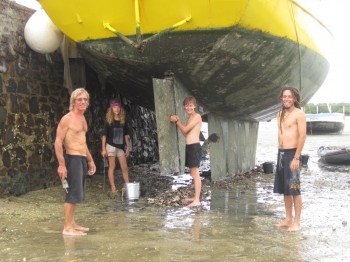
So far as I can see, e-Paint and Eco-speed are the only environmentally-safe antifoulings currently available to us – and the one is suitable only for people who can slip every year, and the other suitable only for folks building new boats or willing to strip off every scrap of old paint; and rich folks, at that.
Where does that leave the rest of us?
Well, I think it leaves us mixing our own homebrew copper-epoxy anti-fouling.
Just how dangerous is copper for the environment?
If you read e-Paint’s website you’ll come away thinking that it’s as bad as TBT, but – with all due respect – e-Paint have an axe to grind. In an effort to discover the truth I’ve been digging around on the internet, and I came up with the following snippets of information:
One study suggests copper is 1,000 times less harmful than TBT.
— Marine Paints – The Particular Case of Antifouling. www.elsevier.com
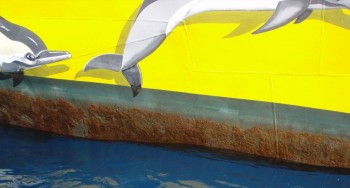
Unlike tin, copper is one of the essential minerals necessary for the growth and health of life, and it occurs naturally in the marine environment. According to the UK Marine Special Areas of Conservation Project:
Copper may exist in a natural water system either in the dissolved form as the cupric (Cu2+) ion, or complexed [with organic or inorganic materials], or as suspended particles present as a precipitate. It can also be adsorbed to bottom sediments or exist as settled precipitates.
Researchers have found indications of the moderation of toxicity in the presence of organic and inorganic ligands.
It is believed that copper is regulated or immobilised in many species and is not biomagnified in food chains to any significant extent.
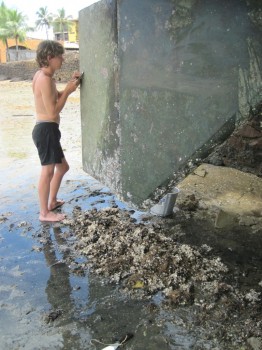
This all sounds quite satisfactory, and other sources are even more reassuring:
The situation [regarding the use of copper in antifouling] has been compounded of late by numerous sources of confusing and misleading information on the subject.
Copper is ideal for use as an antifouling active substance as it is a naturally-occurring material and is an essential element required for normal growth by all plants and animals at low concentrations. As such, it is a normal and essential constituent in the ecosystem in soil, sediment and water.In all the years that copper has been used as an active substance in antifoulings on yachts and pleasure craft, no negative environmental impact on the marine environment has ever been conclusively attributed to copper.
The copper compounds that are commonly approved and used in antifouling paints for underwater hull protection are: copper oxide, copper thiocyanate, and powdered or flake copper metal.
It is generally agreed that one particular form of copper, the cupric ion (Cu++), is most responsible for copper toxicity. Numerous studies have shown that most of the copper present in the marine environment is not present as cupric ion. In fact, the concentration of the cupric ion is at least an order of magnitude lower than the rest of the copper in the environment.
Most of the dissolved copper in marine and freshwater environments is complexed with organic and particulate material. This reduces or completely removes its ability to be taken up by organisms.
This information was brought to us by the Copper Antifouling Environmental Programme (CAEP) and is sponsored by five companies who manufacture copper and copper compounds for use as active ingredients in antifouling paints. Thus, it can hardly be said to be unbiased.
On the other hand, one feels that it is unlikely to be a complete pack of lies.
According to another source:
Nearly all testing of copper has been done in clean seawater without natural complexing agents [ie. without the use of any of the agents which ordinarily bind to the copper and make it unavailable to animals and plants].
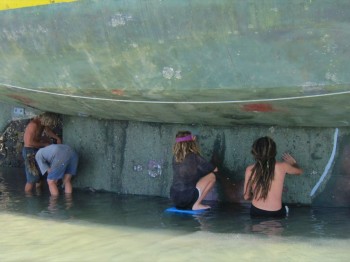
This same report tells us that only 20% of the copper found in the environment exists in its toxic form. Out of 324 samples taken in Southampton, Harwich, and Finland, only one, from close to an input point, exceeded the harmful level. The author concludes:
Bivalves and seaweed are tolerant to copper in the real world – we have underestimated tolerance. We have also overestimated concentrations in the real world.
There is little risk to marine species at current concentrations in harbours, marinas and estuaries. We do, however, need to control inputs of waste paint to stop the build up of copper in sediments.
In other words, the stuff that we paint on our boats doesn’t seem to be doing any harm, but we mustn’t scrape it off and wash it down the slip and into the harbour.
If you are renewing your antifouling and you have to remove old, loose paint then you should sweep up the mess afterwards and dispose of it as you would for any other hazardous waste.
Again, this seems to be good news. Copper is safe, after all! But since the research was carried out on behalf of the Centre for Environment Fisheries and Aquaculture Science we ought, perhaps, to retain just a modicum of scepticism. The fisheries people use copper cages – so they are likely to want to find that copper is safe.
On the other hand, they are unlikely to want to house their fish in something toxic.
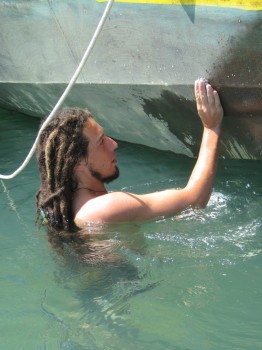
The Netherlands are famous for having banned the use of copper in antifoulings but, according to the CAEP, they have got their facts wrong:
Copper loading in the inland aquatic environment is uniquely high due to the amount of pollution coming from river sources in other parts of Europe. The levels found around inland waters clearly cannot be directly related or significantly affected by the use of copper-containing antifouling paints.
Regardless of this, the Dutch pesticide authorities decided to ban the use of copper-containing antifouling paints on all pleasure craft – not just on those which travel on the inland waters.
In a recent review,
the CAEP tell us, the EU’s leading scientists made a recommendation against the ban.
The CAEP article also points out that whereas shellfish were certainly being damaged while TBT was on their menu, since the ban on the use of tin in yachting antifouls and the consequent return to the use of copper, the shellfish have recovered their health. So, on what basis do we conclude that copper is doing any harm?
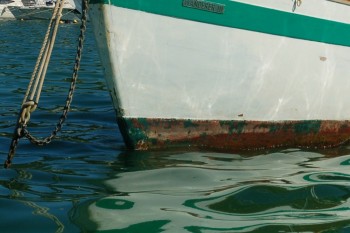
All in all, it would seem that there really is little, or perhaps even NO evidence to suggest that copper-plating the bottom of our boats may be bad for the environment.
Moreover, whereas an ablative copper antifouling is gradually worn away, and will certainly put some measurable amount of copper into the sea, our copper dust home-brew surely leaches almost nothing into the environment.
We recently met up with Thies and Kicki sailing Hiscock’s old Wanderer III. The boat has just turned sixty and is still wearing the copper sheathing which Eric nailed to the hull before the start of her first voyage. So, that gives us a pretty good idea of how much – or how little- debris a copper-bottomed investment puts into the sea.
Finally, then, we come to the questions that everybody keeps asking us: –
What kind of epoxy do you use for the home-brew?
And how much copper powder can you mix into the paint?
Don’t hold your breath, because we don’t know the answer to either of these two questions.
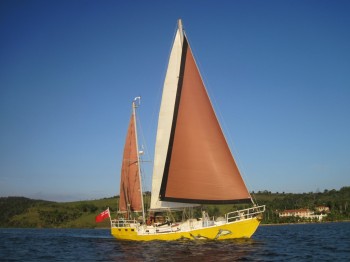
So far as the type of epoxy is concerned – Coppercoat uses a water miscible epoxy, as did the original Copperbot. If anybody is able to find out where one can buy this stuff we would be very glad to hear from you. A lot of people have written to ask.
For want of a water-based epoxy we just used something of approximately the same consistency – stiff enough to hold the heavy powder in suspension but runny enough to go on with a brush. (Coppercoat is surprisingly runny.)
One correspondent adopted a different approach: he ladled the copper into a home-mixed filler and put the stuff on with a trowel.
As to the matter of quantity – our correspondence with Coppercoat suggested that there was a legal maximum to the amount of copper that one can put into an antifoul, but it now appears that this is not true: it seems that there is no legal limit.
One yotty writing to the site complained that his Coppercoat was cracking off the boat. Whilst this may be due to adherence problems it may also have been caused by the use of excessive copper since over-loading the paint is said to have this result.
If anybody has any information to add to the copper-epoxy chapter we would be very glad to hear from you.
Likewise, if anyone has any information about any new methods of inhibiting fouling, please add to this article using the comments form below.

Very interesting read! A new product I came across last week is Thorn-D. It’s a bit expensive, but would (supposedly) at least work for three years: http://www.micanti.com/industries-serving/shipping.html
Thanks for the link. Thorn-D does look interesting; we hadn’t come across it before.
It seems that the main intended use of it is to protect fishing nets from fouling, but I see that the website also mentions use as an antifouling on ships.
It looks like it works by coating the whole of the bottom of the boat in fibres, or ‘thorns’.
To quote from the website, “By applying very specific short fibres (‘thorns’) on a surface, the surface becomes prickly and unattractive for fouling organisms to settle … The basic thought behind Thorn-D® is that a combination of prickliness and swaying of Thorn-D® fibers makes the surface unattractive for organisms to settle.” Interesting.
One point to consider, though, is the friction and disruption to water flow over the hull caused by these fibres. It’s unclear how long the fibres are, but the pictures make them look pretty long (it looks like a roll of carpet in one photo which they show in a few places). This could have a significant impact on boat speed – even a little slime on the bottom has an incredible effect.
We’d be interested to know what Micanti has to say about this issue, and we’d also love to hear from someone who has used this product on their boat.
Incidentally, another issue is that apparently the product must be applied by “authorized and trained partners of Micanti” – presumably an expensive process.
I just found this page about drag tests on the Micanti website – where they state that “Within the shipping industry the main thought for the past decades was; the smoother the surface the better. We have proven this thinking to be wrong.” (no explanation of why it’s wrong…)
However, they continue to say that (emphasis mine) “Though for sail boats the drag is mainly determined by surface drag and a drag increase was found, for most other ships and vessels, the drag increase is comparable to the effect a regular antifouling has on the drag. Moreover, as the drag level is constant, Thorn-D® outperforms the regular antifoulings within 6 months as slime formation increases the drag for regular antifouling coatings.”
It would be nice to know just how much of a drag increase was found.
It is expensive yes, on this Dutch website you can get an idea: http://antifouling.nu/contents/nl/basket.html
I only know they’ve tested it on Pilot-boats in Rotterdam, but no info on drag/efficiency impact.
Wow – €4750 for our boat!
I don’t suppose many people will be using it at that price… it’s way too much for just 5 years of protection (even assuming it works well)!
It’s a shame though, as it looks like one of the few antifouling products which uses no biocides.
Of course, if they wanted to give us a small piece we’d love to test it on our self-steering rudder and write a review on the website! 🙂
I own a 40ft multihull, so it’s not within my budget either;-)
Hello, I just read, and enjoyed, your antifouling article. Very well researched. I’m the fellow who “ladled” the powder into the epoxy. Thus far we are still in the testing stage as the boat is not yet launched. The test piece is submerged in the waters of central Fla and after 3 months has no sign of growth. It’ll be 9 months before we can have it checked again for growth, but we’ll let you know the results.
The recipe: MAS laminating epoxy and as much powder as it takes to make a peanut butter consistency. In future we’ll be testing a “mayonaise” consistency mix. The peanut butter mix worked out to about 1 part epoxy to 3 parts copper powder. Get it on smooth during application, because once it hardens it sands like copper pipe!
Cheers.
P&C on Q.
Hello Paul, Thank-you very much for the report.
That’s a lot of copper! I’m assuming your measurements are by volume – ie 75% copper by volume. Coppercoat and our home-brew are both 30% – and are pretty runny. We were under the impression in the past that this was a legal maximum, but this turns out not to be the case – you can use as much as you like. So we’re definitely interested in trying more next time.
It will be really interesting to hear the results of your longer-term test – do let us know what happens!
Is your test piece in stationary water? What’s the fouling like in the area? Do you have other antifouls under the same conditions, as a comparison?
Hello, thanks for your comments.
The test piece is in a salt water marina environment, the test piece is copper on one side and not covered at all on the other side. The area has a reputation for a lot of growth and we’re hopfull that it will be a good test for our undercoat.
Now, to cover myself, and in the interest of full disclosure, since we ARE on the WWW:
The measurements/ratios are by volume as you stated. As far as “legal” I have not researched copper content in antifoul (the rules are different in each country), as my “undercoating” is for abrasion resistance to enable beaching the boat, NOT anti-fouling. Our tests are simply to understand whether or not an antifouling will be needed.
I’m sure you understand.
Cheers.
Paul.
Hey Paul, I totally understand your legal disclaimer… 🙂 As it happens, even for an antifouling you’d be ok, since there don’t currently seem to be restrictions on amounts of copper (except in the Netherlands).
One thing we were wondering, from a cost and weight point of view, is how think the mix went on – in other words, how much weight of copper did you end up with per square metre, say?
Hello, thanks for your interest.
For more information please send me an e-mail.
Cheers.
Paul.
Hello Paul
How did you trowel on the peanut paste consistency and yet keep it fair for the whole hull?
I guess at that thickness, only one coat is necessary?
I think your idea and recipe is getting close to the correct ratios for “abrasion” resistance.
Thanks
Niels
Hey guys,
Nice article… when I purchased my rusty bucket 6 years ago, she had the original CopperBot coat and seemed to work very well. Had to rebuild the boat and a lot of welding below the water line so it was a pitty the coat had to go. I resumed to regular ablative anti-fouling since I launched her 3 years ago but am getting quite tired and broke from the yearly ordeals, specially now that I’m in a wheelchair.
So I heard of this epoxy and ceramic particles that they use on the structures of offshore oil-rigs and water dams. Many of those big cruise ships have porcelain sea cocks so I reckon it might be worth a shot since nothing really grows on glass or porcelain.
The company that sells the stuff is AtoMetal ( http://www.atometal.net )and from what I read we’d be using AM-C-T200 for the epoxy undercoat and the AM-C-T310 for the epoxy ceramic antifouling.
Has anyone heard of it???
My project this winter is to replace my concrete ballast with lead and incorporate my water tanks in the keel, so there will be a great deal of welding and will sandblast everything below the waterline. So I would like to get it done with a product that I can haul out of the water once a year and have a spray down instead of the regular $1000 yearly ordeal of antifouling.
Cheers
Jon
No, we haven’t heard of ceramic antifouling – although we have heard of a glass-based one which Greenpeace use on their ships, but which apparently only works at high speeds.
Unfortunately there doesn’t seem to be much information around on the web. Atometal’s site does seem to say that the two products you mention would be the relevant ones, but has very little about them.
I don’t know how easy it would be for yotties to get hold of, seeing as they seem to be marketing it for major offshore installations.
I guess we should get in touch with the company and see if they can provide any further information, prices, etc.
If you come across any further information, do please share it here.
Hi Mollymawks!
Greetings from Mauritius! Very interesting article. Before leaving the UK, I watched the guys at Hayling Yacht Company applying a coat of copper to the bottom of a yacht that had just had its osmosis treated. They spread sheets under the boat and ‘pebbledashed’ particulate copper onto wet epoxy paint. I believe they used a hand wound dispenser, very similar to the sort of thing used for applying aggregate to wet rendering. Any excess was picked up and recycled. I reckon that this should achieve close to 100% copper coverage, although longterm adhesion could be a problem. I suppose you could always apply a second coat of epoxy and more particulate copper.
Happy Travels!
Tim, Steph Fin and Sam
s/v Bonaire
ps – great website!
Hi guys, good to hear from you, hope you’re enjoying Mauritius!
That sounds like an interesting method of applying the copper… If it worked then it should achieve a good amount of ‘active’ surface area, but like you say I imagine adhesion could be a problem particularly when scrubbed – one of the best things about the copper-epoxy system is that it’s so durable. I’d love to see a boat where the copper was applied in the way you describe.
From all the info mentioned in both your articles on coppercoat/copperbot; I understand that the difference in the 3 products, copperbot, coppercoat and the home brewed copper mix with epoxy is the amount of copper particulates added to the epoxy. PERIOD!!
The more copper you add the greater the length of protection. PERIOD!!
Actually, I’m not sure about that, Sai.
Yes, it seems that Coppercoat and our own homebrew are just as effective / ineffective, but the Copperbot was a miracle potion. Our friends at Coppercoat tell us that their product is produced to exactly the same formulation as was Copperbot, but the Copperbot which we used was so wonderfully effective that we’re inclined to wonder whether somebody slipped a little something extra into the pot!
So far as the volume of copper is concerned, we’ve tried adding more – we’ve tried laying it on with a trowel, quite literally (on our self-steering rudder) – and it seemed to make no odds. Six months later, you couldn’t tell which parts were painted with the usual ratio of copper to epoxy and which were coated in epoxy-copper putty.
Nor have we had any success by burnishing the Coppercoat. We’ve burnished parts of it, using the grade of paper recommended by the manufacturer, and we’ve had it looking as shiny as could be. But a few weeks later those parts were indistinguishable from the areas which were simply cleaned and sanded by hand.
We’ll be slipping again, in a few weeks time, and if Coppercoat would like to fly out to Argentina and join us, and show us how to do the job properly, we would be delighted.
All this having been said, we would still use a copper-epoxy bottom paint again because, so far as we are concerned, the environment matters more than the cleanliness of our hull. Copper-epoxy is not perfect, but it’s better than nothing and it’s better than poisoning the sea.
We’ve found that the very best way to clean the bottom of the boat is to moor in a polluted river for a couple of months. All the marine weed and so forth dies, and nothing else grows (presumably because the river is dead…). Mind you, it doesn’t get the barnacles off. For that you probably need to moor next to Fukushima.
My wife and I applied Coppercoat to a newly finished steel hulled boat. we followed all the instructions religiously and had suitable temperatures throughout. When finished it looked great and we thought ‘well done us’. Unfortunately it proved to be an expensive mistake. After 2 years we looked like a floating garden. We had the boat lifted and power washed. All the wildlife came off along with about 10% of the paint. We tried again; 2 years later even worse than before. Last summer we lifted again and slapped standard anti-fouling over the entire hull. So far it is doing better than the Coppercoat did.
Coppercoat’s response was to blame us for faulty application or an incompatible undercoat which is an easy out and very difficult to disprove. They then went on to say we’d need to lift the boat every couple of years to scrub off the slime. Given our sailing area at the time this was not much use and I would not ever use Coppercoat again.
In the commercial world of shipping the trend at the moment seems to be towards making hull paint too smooth for sea life to attach to; some paint manufacturers are looking at ceramic / silicon coatings as well as various super secret nano technologies. whether or not these may have environmental side effect i do not know. What I do know is that anti-fouling is a hugely expensive item in the commercial marine world and with current fuel costs there is a big incentive to reduce running costs due to excess marine growth.
It’s a grim story – all that work and all that expense; and I’m very familiar with the feeling of pride and pleasure in a job well done and disappointment when the stuff doesn’t work as well as one hoped and expected.
The manufacturer is certainly inclined to blame anything other than the product, but – with respect – if large amounts of the Coppercoat came off with the sealife this does tend to suggest that there was incompatibility between the two paints. What kind of undercoat or tie-coat did you use? (ie. what was the Coppercoat going on to?)
Hi there,
Interesting, well organized website and well done programming to display it.
I am building a 19m catamaran. Do NOT ask how long its been NOR when we will launch!
We are now on the shore next to a bay in Curacao that is filled with what we call protein soup. It is fish spawning heaven and everything else that can grow in salt water does grow here. We foolishly sold our old boat wa-a-a-y before the new one was ready. But, it was anchored here for about a year and a half. Three months after anchoring here our previously clean bottom had a six to eight inch growth of every creature that likes boat bottoms. Worst we experienced in 15 years of living aboard in the Atlantic, Med and Caribbean. So, I started investigating anti-fouling substances.
Found a company called Ecosea with an interesting product at a horribly high price. Managed to find out that they were using an alloy consisting of 90% copper and 10% nickel embedded in an epoxy coating. Went searching for a manufacturer of the alloy and found that there were only 5 places in the world that made it at that time. I contacted one in the U.S. (now out of business since the world economy has been TBTd to death) and bought around 90 pounds of the stuff.
So here’s where it gets interesting. I prepared a test piece with several bare and coated areas, trying different coating techniques, and tossed it over the side, all test areas facing down. It seemed to work a charm. Checked on it periodically over the next year and some months. NO growth on the treated areas. Then, when the old boat was gone, I had the people helping me build the new boat make a swim platform, to give them some experience. Coated it with the alloy mixed with epoxy and then sanded the surface when all was hard and cured.
It took about six months before the growth showed up. The growth has continued, but at slower pace than compared with what occurred on the bottom of our old boat. Most of the growth and most of the ‘white coral’ could be relatively easily scraped off. My conclusion was that the epoxy matrix holding the alloy provided a starting point for the growth and then that was all she wrote. The alloy parts of the surface seem to have prevented the nasty irreversible attachment of ordinary fouling, but it is still very fouled. So, I decided to modify the technique for applying the alloy. Brush on a very thin layer of epoxy and then use a gun designed to blow sand or dry powder to shoot the alloy onto the wet epoxy. This was similar to the way we had applied it to the test piece. Collect the excess alloy that falls to the ground (or is brushed off when the epoxy cures) on plastic sheets placed there in advance. Obviously you don’t want to get too far ahead of yourself with wet epoxy or it will start to cure. Can’t tell you how it will work because the new boat is not yet in the water.
The idea behind the alloy is this. Copper works but is leached away by the sea water. The reason the old copper plates worked well is that they were relatively thick and leaching didn’t matter. The new copper coatings suffer from leaching and lose their effectiveness in 1 to 2 years. In the alloy, the nickel binds to the copper and prevents nearly all the leaching. Nickel is also very toxic, but it DOESN’T leach away. Therefore, the nickel doesn’t affect anything not in direct contact with it. Wish I could afford a nickel plated bottom. If you try this, be aware that you can develop contact dermatitis. That is, your body reacts to the nickel and you develop a bad rash, not necessarily where you touched the powder, but somewhere on your skin because your body is very upset about things. It’s sort of like a bad allergy.
Conclusions: NiCu powder (100nm average diameter particles) may work well if all is done correctly, but I can’t say that for sure just yet. NiCu powder is difficult to locate and initially expensive. I have about 100m2 of surface underwater and I paid around $2000 for enough powder to coat it 5 years ago. But, it should last for 10 years easily IF you can get it to work for you.
Fair winds.
Steve
Hi,
Looking at all the coments about antifouling and costs, it occured to me that maybee
, just maybe the effectiveness of the coppercoat is somehow influenced by the steel hull? Do people with GRP hulls have the same problem, any comments will be apreciated.
Regards Len
Ps My Boat is in the Mar menor spain, very high fouling area!!
I have read that UV light blinds barnacle larvae and then they do not attach.
http://www.nature.com/news/2003/030226/full/news030224-4.html
There are countless numbers of larvae, killing them around your ship wont harm their awesome numbers.
They are attracted like bugs to a light, so maybe only need a couple of UV lights either built into the hull of around the hull..
Perhaps underwater UV lights exist? Of course they take power to run. My thoughts, if UV works, boats slipped at marinas with electric shore power could afford to use such a system.
Hi Jill & crew of Molly hawk,
The dilemma continues!
No mention was made on the type of epoxy used in copperbot.
Was the copperbot 100% solids standard laminating epoxy or was it water based?
Does it make any difference?
I understand coppercoat is water based, Whether type 1 or type 2 is of interest. I wonder if it is the non-reactive
emulsifier type which could allow a more even Cu salt dispersion. ie non-phenyl based diluant.
It seems a little like chasing shadows as the same product does not seem to produce consistent repeatable results.
Imo, copper powder/epoxy carrier combinations are the most ocean friendly. From what I have read anyway.
Application is critical, both in substrate prep and application of thin multiple coats to enable exposure of copper.
Obviously no antifouling is going to be completely benign, but it is important to find one that is more deterent than
toxic. Alas, sound seems difficult to implement.
My daughter has more than a passing interest in establishing a template of “cues” to attract sealife to recolonise
reef sites.
http://www.plosone.org/article/info%3Adoi%2F10.1371%2Fjournal.pone.0028572
It doesn’t necessarily follow that the reverse is also genetically imprinted.
Fair winds,
Roly Stanley
We bought our boat 2009, coppercoat had been applied but dont know when, had a repair to both hulls and coppercoat applied to both bows about 1m along water. I used to dive and scrape scrub with scourers and paint scrapers monthly in Sydney harbour, and up into QLD. the cat ended up on a mooring for the best part of 4 years, we’ve just hauled out and there was severe attachments of barnacles, some oysters, weed etc except for the newly appied coppercoat which was almost slime free!!!! I had been talked into applying ablative and this forum hasn’t helped me return to the original desire for enviro friendly epoxy copper. Our boeat is not steel, its glass over timber. Regards Peter
For background, I started off as a Civil and Structural Engineer, and have done loads of things since (skilled Electrical Engineer, custom computer builder, designed a few things like special copper nails, import/export and wholesale/retail of building products such as slates, granites, etc., etc., also am a qualified Wildlife Manager and qualified Advanced Marksman), had a deep interest in environmental issues for almost 50 years, have subscribed to more Scientific journals for way too long (until fake science came to dominate – and yeah, I have a very big axe to grind about that, and so many frauds and lies that are committed under the banner name of ‘environmentalism’ today) considering the expenditure. But I have picked up a few things along the way. An along the way that also included living off grid for over 30 years, and a lot of sailing here and there too (I have built a couple of boats but have no boat now).
First things first, you have hit on the reality that copper is an indispensable essential in the environment. In fact copper deficiency is really serious, and I know this because where I live the ground has a serious copper deficiency (as an aside, sulphur deficiency is also serious, and due to the reduction in ’emissions’ which gave land free fixes of essentials such as sulphur, farmers are now having to pay a lot of money to buy sulphur to spread on the land). My farming neighbours have to give their livestock copper pills and copper drenches to prevent serious damage (what they call ‘staggers’ in sheep, for example).
I never liked the use of TBT in antifouling, but I did like the concept of a self polishing antifoul. I am extremely wary of organophosphates and the damage they are doing. My neighbour died a couple of years ago from ‘CJD’, but the truth was (and this was confirmed by his specialist, despite what was put on the death certificate), as a sheep farmer, he had ‘CJD’ from the organophosphate in sheep dip. Cattle have been getting it from organophosphate in warble fly treatment (poured down the spine of the animal, and from there, fast tracked into the brain, is how it looks to function).’CJD’ doesn’t look to be a disease or ‘transmittable’ it looks to be a chronic poisoning problem.
So back to copper and antfouling. I wouldn’t worry about using it, at all. Personally, I would house the copper particles in the toughest, most water resistant and durable epoxy resin, I could lay my hands on (for full anti osmosis and lifespan benefit). I am wondering if coppercoat is ‘hit or miss’ due to how runny it is tbh. To me that suggests that the copper particle count (the amount of copper per litre of paint) is being reduced to an absolute minimum (copper being expensive, though it isn’t ‘that’ expensive – it didn’t cost me much to get my copper nails made in bulk, and I sold them cheap – while maintaining a reasonable profit otherwise the business would have gone bust – to encourage the use of a proper nail fit for purpose – but then as a Capitalist rather than a Corporate Socialist – what today is widely confused with Capitalism, and it is no accident – I am neither a Monopolist, a Cartelist, nor Anti-Competitive, nor Anti-Job, nor a Racketeering Crook, nor am I GREEDY).
I think people are coming at this from the wrong direction in many cases (e.g. people asking what particle size you are using). Instead, look at it like concrete, where various particle sizes (up to large aggregate, and down to dust) are used to make a good concrete.
The important question, to me, is how thick is the layer of epoxy that is going on in one coat? The maximum particle size then has to be less than that thickness (I would go with maybe about 50% to 60% of the coat thickness?) for ease of application. To me, it would appear that you do not want any significant gaps between the copper particles. I think it is the ‘gaps’ which are filled with the epoxy resin, that are acting as host for fouling to become established, and with ‘burnishing’ back to the copper, if there is too much epoxy to aggregate ratio, then you are ‘keying’ the epoxy to give fouling a firm grip to get started. So I would combine aggregate sizes down to sufficiently small, to obtain sufficient gap filling, and do a final ‘burnish’ with a very fine abrasive to reduce the impact of excessive ‘keying’ and ease self cleaning. Jewellers Rouge springs to mind as perhaps providing a perfect final finish (though perfect probably isn’t essential), and to get there, you wouldn’t want to start with an excessively coarse abrasive. Don’t put in excessive ‘keying’ that you then have to take out.
Personally I would try for an application consistency similar to household vinyl emulsion (obviously you have to compensate for the consistency of the epoxy you are using). Then you should have excellent particle content, in a form that can be rapidly applied with a roller (believe it or not – grins – along the way I have also been a decorator, and two of us could do one coat, walls and ceiling of a dormitory in a hostel, in under 20 minutes – and I think it’s that sort of performance you need, to be able to speedily apply multiple coats at the tacky stage).
Then once it has fully cured, I would use a belt sander (not an orbital one) to get everything faired off smooth and cut back to exposed copper. Also, it might pay to have two experiments. First I would start with fine belts, and lightly work horizontally, along the line of flow of water, with the idea that the final polish would have small keying marks in the flow direction, and the flow along the exposed copper should help to keep them clean. The second experiment I would do the opposite, vertical from waterline to keel, which would give small vertical scratches in the polishing. This ‘might’ produce micro turbulence (maybe even compression bubbles) and improve performance as well as also help to keep the micro keying clear. Apart from other reasons (such as inexperienced hands can make a real mess with one), this is why I wouldn’t use an orbital sander – keying marks will be all over the place. In a way this is illustrated like with the use of uPVC plastics (for guttering, fascia boards, etc). The ‘skin’ is so soft, the worst thing you can do is wipe it clean, because you put fine scratches in the surface, and all manner of growth gets in them and your plastics look a mess before you can blink. I also used to sell very good quality plastics, and I used to tell my customers to buy marine grade clear liquid silicon polish (that leaves a ‘diamond’ like finish), then as they peeled the plastic protective wrap off the surface after fixing, use cotton wool to gently wipe this polish onto the surface of the plastic, to give it a durable hard shell coating. We did this to my parents fascias almost 30 years ago, and they are like new today. I don’t touch them, I just hose them down now and again.
Unfortunately I am not in a position presently to test this epoxy/copper myself (frankly I’d go with the second method first, and I’d use enough coats of epoxy/copper to be able to buff it out after a few years and try the first method), and it looks to be a few years before I will be in a position to have a boat to use it on, but when I do, I will be using this principle to make my own anti-fouling, unless a commercial organisation produces something similar and effective, that isn’t a blatant rip-off.
In the meantime hopefully Cartel, Monopolistic, Racketeering, Internationalist (Communist) Corporate Socialism, will have died its now overdue, and inevitable final self destruction. Buckle up, there’s a storm coming.
Hi Mollymawks,
I have a 10′ GRP SV and have been looking for a poison free anti-foul. Love your article and research – thank you.
The research Ive seen suggests a yearly scrub-down but i can understand if this varies from place to place.
One anti foul method was electrodes placed at bow and stern to create an electric field around the hull and discourage fouling. Not sure how well it works, but I was wondering if the copper reacts with the salt water to create a small electric field and that if another particle was added, it may intensify that field (carbon? zinc?). The next questions , how much would this affect the electrolysis of the vessel and would the effects be worse than having to clean the plain copper impregnated epoxy?
Really interested to hear thought on the subject.
Cheers
Jon
Update
In lieu of something better I went ahead with 3 coats of west 105 & 2kg/l of 300 mesh semi spherical copper powder, 3 coats wet on tacky. Frequently stirred whilst applying. Applied 3 thin coat to about a total 600microns.
Went for the 100% solids non-WB epoxy as we didn’t want to have to remove to recoat in future and wanted retain more barrier properties.
RO back with 180 grit to expose raw copper then 400 for polish.
One & half years later we are pleased with the results. Easily cleaned by hand every 3-4 months with a plastic scraper.
The RIB left alongside for 4 mths was a mess and required an acid to break down the hard shell base.
Picture of the RIB after four months- This is after a hard scrub. None of the oyster adhered to the yacht.
http://crew.org.nz/forum/index.php/topic/13257-a-not-anti-fouling-anti-fouling/page-10
Roly
Thanks for sharing your experiences, Roly. Always glad to hear from someone for whom the environmentally sound way is working!
You may find this more recent research on acoustic anti-fouling interesting:
http://www.sciencedirect.com/science/article/pii/S0029801815001572
Thanks for that. Our recent experience of recording dolphin vocalisations has made us very aware of the potential problem of “noisy” antifouling.
Hi guys, awesome blog with non biased, honest opinions.
Have you heard of barnicalerid. An electronic system utilizing copper electrodes hung from the ends of a vessel, creating a cu ion field. It’s an Australian company which has been running for 9 years. Website reads very positive, as it would, but very hard to find independent reviews, negative or positive.
Cheers and thanks for your blog.
Hullo Mark,
No, we haven’t heard of this. We’ll check it out.
We’re just about to slip and do the antifouling again, so it’s a matter of pressing concern to us at the moment.
Thanks for the information,
Jill
Your most welcome Jill. Could you let me know your findings as I’m pretty keen on the product myself, just a little wary.
Cheers,
Mark